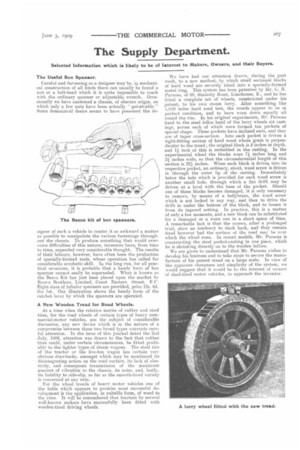The Supply Department.
Page 19

If you've noticed an error in this article please click here to report it so we can fix it.
Selected Information which is likely to be of Interest to Makers, Owners, and their Buyers.
The Useful Box Spanner.
Careful and far-seeing as a designer may be, in mechanical construction of all kinds there can usually be found a nut or a bolt-head which it is quite impossible to reach with the ordinary spanner or adjustable wrench. Occasionally we have examined a chassis, of obscure origin, on which only a few nuts have been actually " get-at-able." Some demoniacal desire seems to have possessed the de signer of such a vehicle to render it as awkward a matter as possible to manipulate the various fastenings throughout the chassis. To produce something that would overcome difficulties of this nature, inventors have, from time to time, expended very considerable thought. The results of their labours, however, have often been the production of specially-formed tools, whose operation has called for considerable acrobatic skill. In the long run, for all practical occasions, it is probable that a handy form of box spanner cannot easily be superseded. What is known as the Beeco Kit has just been placed upon the market by Brown Brothers. Limited, Great Eastern Street, E C. Eight sizes of tubular spanners are provided, price 12s. M. the lot. Our illustration shows the handy form of the ratchet lever by which the spanners are operated.
A New Wooden Tread for Road Wheels.
At a time when the relative merits of rubber and steel tires, for the road wheels of certain types of heavy commercial-motor vehicles, are the subject of considerable discussion, any new device which is in the nature of a compromise between these two broad types warrants careful attention. In the issue of this journal dated the 2nd July, 1908, attention was drawn to the fact that rubber tires could, under certain circumstances, be fitted profitably to the lighter types of steam wagons. The steel tire of the tractor or the five-ton wagon has certain very obvious drawbacks, amongst which may be mentioned its disintegrating action on the road surface, its lack of elasticity, and consequent transmission of the maximum amount of vibration to the chassis, its noise, and, lastly, its liability to side-slip, so far as the smooth-tired variety is concerned at. any rate.
For the wheel treads of heavy motor vehicles one of the fields which appears to promise most successful development is the application, in suitable form, of wood to the rims. It will be remembered that tractors by several well-known makers have successfully been fitted with wooden-tired driving wheels. We have had our attention drawn, during the past week, to a new method, by which small sectional blocks of hard wood are securely fitted into a specially-formed metal ring. This system has been patented by Mr. G. R. Parsons, of 69, Stain sby Road, Limehouse, E., and he has fitted a complete set of wheels, constructed under his patent, to his own steam lorry. After something like 1,060 miles hard road test, the treads appear to be in perfect condition, and to have worn down equally all round the rim. In his original experiments, Mr. Parsons fixed to the steel fence band of the lorry wheels six cast-. ings, across each of which were formed ten pockets of special shape. These pockets have inclined ends, and they are of taper cross-section. Into each pocket is driven a tight-fitting section of hard wood whose grain is perpendicular to the tread; the original block is 3 inches in depth, and 1 inch of this is embedded in the casting. In the experimental wheel the blocks were 74 inches long and 2i inches wide, so that the circumferential length of this section is 221 inches. When each block is driven into its respective pocket, an ordinary, stout, wood screw is driven in through the outer lip of the casting. Immediately below the hole which is provided for each wood screw is another small hole, through which a flat drift may be driven at a level with the base of the pocket. Should one of these blocks become damaged, it is only necessary to remove, by means of a bellybrace, the wood screw which is not locked in any way, and then to drive the drift in under the bottom of the block, and to loosen it from its tapered setting. In practice, this is a matter of only a few moments, and a new block can be substituted for a damaged or a worn one in a short space of time. A remarkable fact is that the screws, after a prolonged trial, show no tendency to slack back, and they remain fixed however bad the surface of the road may be over which the wheel runs. In recent models, Mr. Parsons is constructing the steel pocket-casting in one piece, which he is shrinking directly on to the wooden felloes.
We are given to understand that Mr. Parsons wishes to develop his business and to take steps to secure the manufacture of his patent tread on a large scale. In view of the apparent cheapness and simplicity of the system, we would suggest that it would be to the interest of owners of steel-tired motor vehicles, to approach the inventor.




















